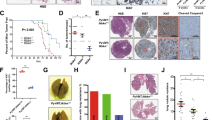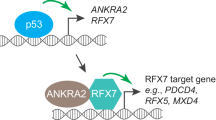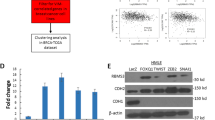Abstract
The ETS1 transcription factor is a member of the Ets family of conserved sequence-specific DNA-binding proteins. ETS1 has been shown to play important roles in various cellular processes such as proliferation, differentiation, lymphoid development, motility, invasion and angiogenesis. These diverse roles of ETS1 are likely to be dependent on specific protein interactions. To identify proteins that interact with ETS1, a yeast two-hybrid screen was conducted. Here, we describe the functional interaction between SP100 and ETS1. SP100 protein interacts with ETS1 both in vitro and in vivo. SP100 is localized to nuclear bodies and ETS1 expression alters the nuclear body morphology in living cells. SP100 negatively modulates ETS1 transcriptional activation of the MMP1 and uPA promoters in a dose-dependent manner, decreases the expression of these endogenous genes, and reduces ETS1 DNA binding. Expression of SP100 inhibits the invasion of breast cancer cells and is induced by Interferon-α, which has been shown to inhibit the invasion of cancer cells. These data demonstrate that SP100 modulates ETS1-dependent biological processes.
This is a preview of subscription content, access via your institution
Access options
Subscribe to this journal
Receive 50 print issues and online access
$259.00 per year
only $5.18 per issue
Buy this article
- Purchase on SpringerLink
- Instant access to full article PDF
Prices may be subject to local taxes which are calculated during checkout








Similar content being viewed by others
References
Baillat D, Begue A, Stehelin D and Aumercier M . (2002). J. Biol. Chem., 277, 29386–29398.
Bassuk AG and Leiden JM . (1995). Immunity, 3, 223–237.
Bergeron D, Barbeau B, Leger C and Rassart E . (1995). Cell Mol. Biol. Res., 41, 155–159.
Bhat NK, Romano-Spica V, Georgiou P, Chen SL, Kui PG and Suzuki H . (1994). Hybridoma, 13, 1–8.
Bloch DB, Chiche JD, Orth D, de la Monte SM, Rosenzweig A and Bloch KD . (1999). Mol. Cell. Biol., 19, 4423–4430.
Cairns RA, Khokha R and Hill RP . (2003). Curr. Mol. Med., 3, 659–671.
Chen Z, Fisher RJ, Riggs CW, Rhim JS and Lautenberger JA . (1997). Cancer Res., 57, 2013–2019.
Czuwara-Ladykowska J, Sementchenko VI, Watson DK and Trojanowska M . (2002). J. Biol. Chem., 277, 20399–20408.
Delannoy-Courdent A, Mattot V, Fafeur V, Fauquette W, Pollet I, Calmels T, Vercamer C, Boilly B, Vandenbunder B and Desbiens X . (1998). J. Cell Sci., 111 (Part 11), 1521–1534.
Dittmer J . (2003). Mol. Cancer, 2, 29.
Farr A and Roman A . (1992). Nucleic Acids Res., 20, 920.
Fisher RJ, Mavrothalassitis G, Kondoh A and Papas TS . (1991). Oncogene, 6, 2249–2254.
Foos G, Garcia-Ramirez JJ, Galang CK and Hauser CA . (1998). J. Biol. Chem., 273, 18871–18880.
Ghysdael J and Boureux A . (1997). The ETS Family of Transcriptional Regulators. Birkhauser Verlag Basel: Switzerland.
Gongora R, Stephan RP, Zhang Z and Cooper MD . (2001). Immunity, 14, 727–737.
Graves BJ and Petersen JM . (1998). Adv. Cancer Res., 75, 1–55.
Guldner HH, Szostecki C, Grotzinger T and Will H . (1992). J. Immunol., 149, 4067–4073.
Gyuris J, Golemis E, Chertkov H and Brent R . (1993). Cell, 75, 791–803.
He TC, Zhou S, da Costa LT, Yu J, Kinzler KW and Vogelstein B . (1998). Proc. Natl. Acad. Sci. USA, 95, 2509–2514.
Hodges M, Tissot C, Howe K, Grimwade D and Freemont PS . (1998). Am. J. Hum. Genet., 63, 297–304.
Hsu T, Trojanowska M and Watson D . (2004). J. Cell. Biochem., 91, 896–903.
Huang CC, Papas TS and Bhat NK . (1997). Oncogene, 15, 851–856.
Ishov AM, Sotnikov AG, Negorev D, Vladimirova OV, Neff N, Kamitani T, Yeh ET, Strauss III JF and Maul GG . (1999). J. Cell Biol., 147, 221–234.
Iwasaka C, Tanaka K, Abe M and Sato Y . (1996). J. Cell Physiol., 169, 522–531.
Kavurma MM, Bobryshev Y and Khachigian LM . (2002). J. Biol. Chem., 277, 36244–36252.
Kerbel R and Folkman J . (2002). Nat. Rev. Cancer, 2, 727–739.
Kita D, Takino T, Nakada M, Takahashi T, Yamashita J and Sato H . (2001). Cancer Res., 61, 7985–7991.
Lamond AI and Earnshaw WC . (1998). Science, 280, 547–553.
Lehming N, Le Saux A, Schuller J and Ptashne M . (1998). Proc. Natl. Acad. Sci. USA, 95, 7322–7326.
Li R, Pei H and Papas T . (1999). Proc. Natl. Acad. Sci. USA, 96, 3876–3881.
Li R, Pei H and Watson DK . (2000a). Oncogene, 19, 6514–6523.
Li R, Pei H, Watson DK and Papas TS . (2000b). Oncogene, 19, 745–753.
Maul GG, Negorev D, Bell P and Ishov AM . (2000). J. Struct. Biol., 129, 278–287.
Negorev D, Ishov AM and Maul GG . (2001). J. Cell Sci., 114, 59–68.
Obika S, Reddy SY and Bruice TC . (2003). J. Mol. Biol., 331, 345–359.
Oda N, Abe M and Sato Y . (1999). J. Cell Physiol., 178, 121–132.
Oettgen P, Finger E, Sun Z, Akbarali Y, Thamrongsak U, Boltax J, Grall F, Dube A, Weiss A, Brown L, Quinn G, Kas K, Endress G, Kunsch C and Libermann TA . (2000). J. Biol. Chem., 275, 1216–1225.
Pei H, Yordy JS, Leng Q, Zhao Q, Watson DK and Li R . (2003). Oncogene, 22, 2699–2709.
Quaranta V and Giannelli G . (2003). Tumori, 89, 343–348.
Ramakers C, Ruijter JM, Deprez RH and Moorman AF . (2003). Neurosci. Lett., 339, 62–66.
Rorth P, Nerlov C, Blasi F and Johnsen M . (1990). Nucleic Acids Res., 18, 5009–5017.
Rutter JL, Mitchell TI, Buttice G, Meyers J, Gusella JF, Ozelius LJ and Brinckerhoff CE . (1998). Cancer Res., 58, 5321–5325.
Schneikert J, Peterziel H, Defossez PA, Klocker H, Launoit Y and Cato AC . (1996). J. Biol. Chem., 271, 23907–23913.
Seeler JS and Dejean A . (1999). Curr. Opin. Genet. Dev., 9, 362–367.
Seeler JS, Marchio A, Sitterlin D, Transy C and Dejean A . (1998). Proc. Natl. Acad. Sci. USA, 95, 7316–7321.
Sementchenko VI, Schweinfest CW, Papas TS and Watson DK . (1998). Oncogene, 17, 2883–2888.
Sementchenko VI and Watson DK . (2000). Oncogene, 19, 6533–6548.
Stacey KJ, Fowles LF, Colman MS, Ostrowski MC and Hume DA . (1995). Mol. Cell. Biol., 15, 3430–3441.
Stamenkovic I . (2003). J. Pathol., 200, 448–464.
Sternsdorf T, Grotzinger T, Jensen K and Will H . (1997). Immunobiology, 198, 307–331.
Sternsdorf T, Jensen K, Reich B and Will H . (1999). J. Biol. Chem., 274, 12555–12566.
Szostecki C, Guldner HH, Netter HJ and Will H . (1990). J. Immunol., 145, 4338–4347.
Szostecki C, Will H, Netter HJ and Guldner HH . (1992). Scand J. Immunol., 36, 555–564.
Verger A and Duterque-Coquillaud M . (2002). BioEssays, 24, 362–370.
von Marschall Z, Scholz A, Cramer T, Schafer G, Schirner M, Oberg K, Wiedenmann B, Hocker M and Rosewicz S . (2003). J. Natl. Cancer Inst., 95, 437–448.
Wang L, Wu WZ, Sun HC, Wu XF, Qin LX, Liu YK, Liu KD and Tang ZY . (2003). J. Gastrointest. Surg., 7, 587–594.
Wasylyk B, Hagman J and Gutierrez-Hartmann A . (1998). Trends Biochem. Sci., 23, 213–216.
Wasylyk B, Wasylyk C, Flores P, Begue A, Leprince D and Stehelin D . (1990). Nature, 346, 191–193.
Wasylyk C, Bradford AP, Gutierrez-Hartmann A and Wasylyk B . (1997). Oncogene, 14, 899–913.
Wasylyk C, Gutman A, Nicholson R and Wasylyk B . (1991). EMBO J., 10, 1127–1134.
Wasylyk C, Schlumberger SE, Criqui-Filipe P and Wasylyk B . (2002). Mol. Cell. Biol., 22, 2687–2702.
Watson DK, Li R, Sementchenko VI, Mavrothalassitis G and Seth A . (2002). Encyclopedia of Cancer Vol. 2. Bertino JR (ed). Academic Press: New York, pp 751–758.
Westermarck J, Seth A and Kahari VM . (1997). Oncogene, 14, 2651–2660.
Xu D, Wilson TJ, Chan D, De Luca E, Zhou J, Hertzog PJ and Kola I . (2002). EMBO J., 21, 4081–4093.
Yang X, Khosravi-Far R, Chang HY and Baltimore D . (1997). Cell, 89, 1067–1076.
Yordy JS and Muise-Helmericks RC . (2000). Oncogene, 19, 6503–6513.
Zong RT, Das C and Tucker PW . (2000). EMBO J., 19, 4123–4133.
Acknowledgements
We thank Dr R Brent (The Molecular Sciences Institute, Berkeley, CA) for providing the yeast two-hybrid reagents, Dr R Tjian (University of California, Berkeley) for the pCMV-c-fos and pCMV-c-jun plasmid, Drs J Rutter and C Brinckerhoff (Dartmouth Medical School, NH) for the pGL3-MMP1-2G and pGL3-MMP1-1G plasmids, and Dr Andrew CB Cato for the MMP1-517/+63 luciferase plasmid. This work was supported in part by grants from the National Institutes of Health Grant P01CA78582 (DKW) and American Cancer Society Grant IRG97-151 (RL), as by the Wachovia Hollings Cancer Center scholarship and a Cato scholarship (JSY).
Author information
Authors and Affiliations
Corresponding author
Rights and permissions
About this article
Cite this article
Yordy, J., Li, R., Sementchenko, V. et al. SP100 expression modulates ETS1 transcriptional activity and inhibits cell invasion. Oncogene 23, 6654–6665 (2004). https://doi.org/10.1038/sj.onc.1207891
Received:
Revised:
Accepted:
Published:
Issue Date:
DOI: https://doi.org/10.1038/sj.onc.1207891



